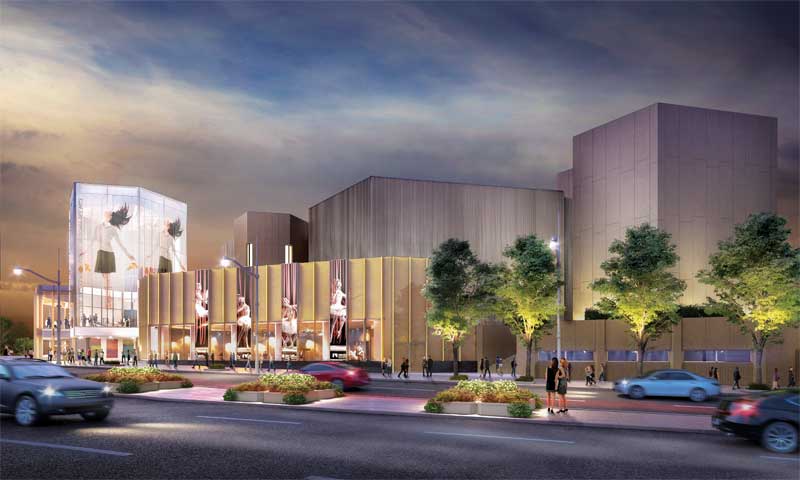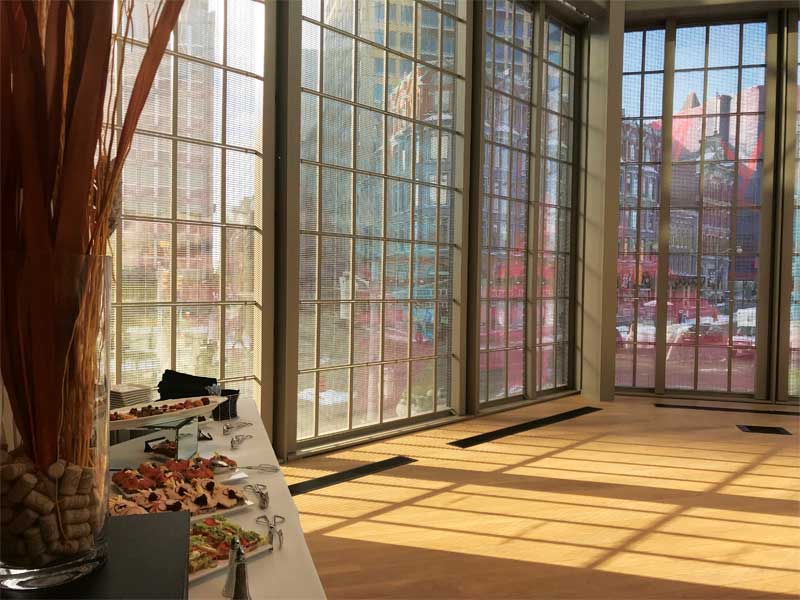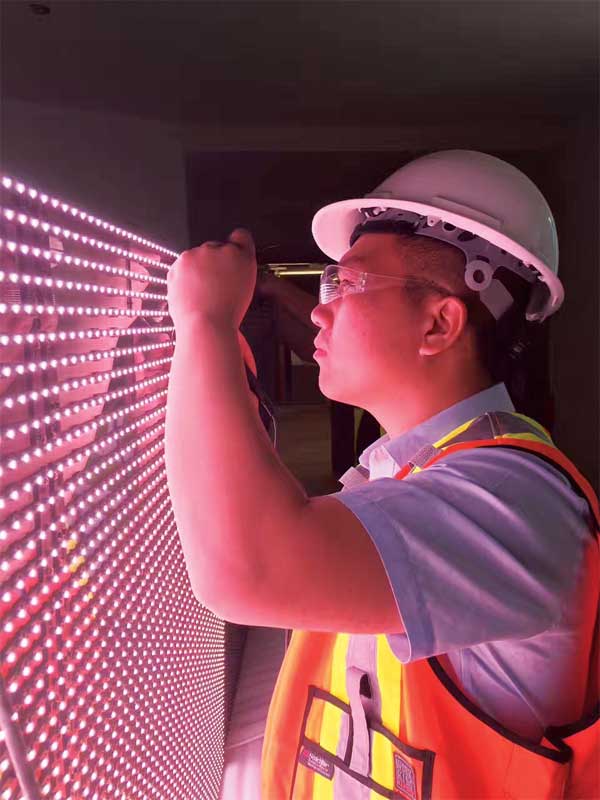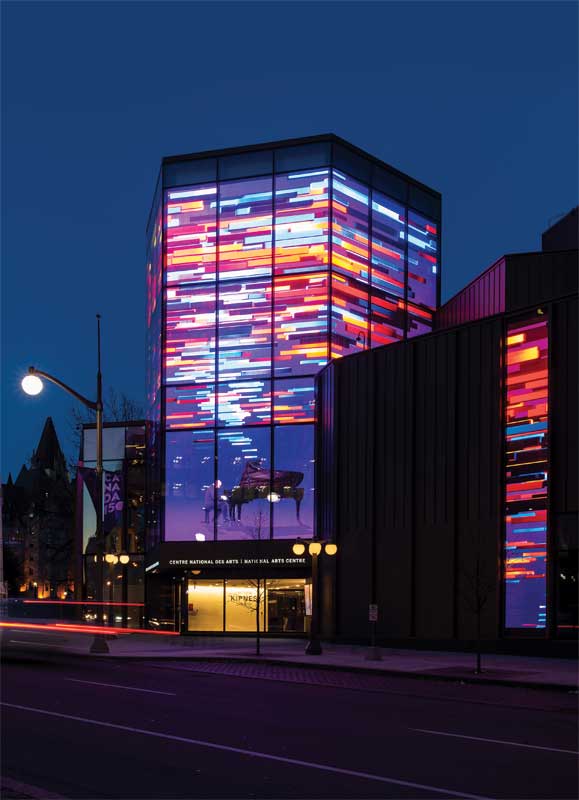Digital Signage: Creating North America’s largest transparent LED screen
by all | 3 April 2018 11:33 am
 [1]
[1]Photo by Trevor Lush, courtesy Moment Factory
By Peter Saunders
On New Year’s Eve, following a countdown to midnight in -30 C (-22 F) weather, the National Arts Centre (NAC) in Ottawa began displaying colourful, dynamic images on the Kipnes Lantern. The three-storey glass tower, which frames the performance facility’s new Elgin Street entrance, incorporates what is reportedly the largest transparent light-emitting diode (LED) screen anywhere in North America, specially designed to showcase productions from both the stages of the NAC and those of other performing arts organizations throughout the country.
“The Lantern showcases the breadth and excellence of music, theatre and dance being produced across Canada,” says the NAC’s CEO, Peter Herrndorf.
An architectural vision
The Lantern represents the latest phase in a $225-million renewal of the NAC, which is intended to transform a mid-century Brutalist structure into a more open and inviting facility. The building had faced the Rideau Canal, rather than Ottawa’s downtown core, ever since it opened in 1969. One of the goals of the renewal was to move the facility’s front door to Elgin Street.
“We were hired by the NAC to conduct feasibility studies in 2011,” explains Jennifer Mallard, a senior associate with Toronto-based Diamond Schmitt Architects. “The side of the building facing the city was opaque and we were tasked with establishing a new point of connection there.”
These studies led to the proposal for the addition of the three-storey hexagonal glass tower, echoing the existing building’s geometry. The idea of adding a see-through digital screen as a ‘fifth stage’ for the four-stage arts complex was developed by Donald Schmitt, one of the firm’s principals, and Herrndorf during the planning process.
“The see-through technology of the screen would complement the transparency established in the new public wings providing the connection with downtown Ottawa and views of nearby landmarks,” Schmitt explains.
Integrating the hardware
To turn the notion into reality, the architects considered a variety of technologies, including digital projection and window films, before turning their attention to transparent LED screens, which had been used in the entertainment industry and for other commercial purposes. Renderings were developed, based on the structure’s size and location, with sample images of dancing ballerinas, orchestra conductors and theatrical performances.
“For this application, it was important for the imagery to appear graceful, elegant, slow and not too commercial,” says Mallard.
After municipal authorities were satisfied the content would be appropriate for the site and the screen’s brightness would be fully adjustable (Mallard says the city’s urban design review panel was “very enthusiastic” about the idea), the NAC issued a request for proposals (RFP) for the hardware. The winning bid came from ClearLED in Burnaby, B.C., which—as its name suggests—specializes in the custom fabrication of transparent LED displays.
“We opened a design-build process with them, whereby test video reels were developed before anything was physically built,” says Mallard.
One key decision was to install the LEDs inside the tower, rather than engineer an outdoor-durable display.
“By eliminating the need for outdoor-proofing techniques, we were able to keep the printed circuit boards (PCBs)—to which the LEDs are soldered—as narrow as possible, so as to achieve both high resolution and a high level of transparency,” explains Jin Fan, CEO of ClearLED. “For this project, the PCBs are 2 mm (0.08 in.) thick and 6 mm (0.24 in.) wide. The pixel pitch is 16 mm (0.6 in.).”
 [2]
[2]With the addition of the Kipnes Lantern, Diamond Schmitt Architects envisioned making the NAC more open to downtown Ottawa.
Rendering courtesy Diamond Schmitt Architects
Prototypes were developed before settling on the final system.
“We were brought on board in 2016, when the architectural designs were done and the steel structure was already in place,” says Fan. “The architects had seen our products in 2014, but there was a lot of customization needed for this project. They did not want exposed screwheads, for example, so we used countersunk screws with powdercoated covers that were the same colour as the building.”
Mounted on L-shaped aluminum brackets attached to the structure’s steel beams, the LEDs were angled slightly downward, to face pedestrians below the 400-m2 (4,306-sf) display. The PCBs were painted black on the display side to increase contrast levels and white on the back to minimize their visibility from inside the tower. The chassis to house the associated electronic components was designed in alignment with the steel architecture. In these ways, the integration of the display was made as visually seamless as possible.
In addition to providing the transparent digital screen, which spans four sides of the Lantern, ClearLED also built four smaller, solid, vertical ‘fin’ or ‘blade’ LED screens to
be installed along the building’s Elgin Street façade. All of the displays use programmed ambient light sensors and are automatically dimmed in response.
So far, the Lantern is only illuminated after 4 p.m., when sunlight is already fading in wintertime, but it is also designed for full daylight visibility, with a maximum brightness of 8,000 nits.
“It might be used during the day for special occasions,” says Fan.
The installation of the displays was completed in time for the official inauguration of the NAC’s renewal on July 1, 2017, with the opening of improved performance spaces, new wings for audiences and presentations and the aforementioned reorientation of the building to open onto the city’s downtown core, after having its concrete back turned on Ottawa for nearly 50 years. At that point, however, there was not yet any customized content to be displayed.
“The whole project had a very aggressive building schedule so it could open for Canada Day, with Prince Charles in attendance,” says Mallard, “but it would take longer to get the messaging right.”
 [3]
[3]The integration of the display was made as visually seamless as possible.
Photos courtesy ClearLED
Getting the content right
The development of the content strategy had begun in 2016, shortly after ClearLED became involved. The NAC’s Herrndorf assigned Christopher Dearlove and Bridget Mooney as project leaders for animation, based on their own project management backgrounds in the arts community.
“Peter had a vision for using the Lantern as a platform for elevating and celebrating great performances from across the country,” says Dearlove. “It would also be like a digital ‘campfire’ where people would come together in a public space. Ottawa doesn’t have many places like that.”
One of their key challenges was determining which content would play out well on a transparent screen.
“There weren’t a lot of them in use for comparison’s sake,” says Mooney. “I had only seen some while on a personal trip in Dubai, U.A.E. So, we had a lot to learn about the technology.”
The NAC already had lots of content from its own performances, but it was apparent a media agency partner would be needed to get the most out of those assets. Another RFP was issued, through which Montreal-based Moment Factory—well-known for large-scale nighttime projection mapping projects—was brought on-board in early 2017.
 [4]
[4]The LEDs were soldered to printed circuit boards (PCBs) that are narrow enough to achieve a high level of transparency.
“Our in-house designers created content, such as a waving Canadian flag and falling maple leaves, to test the displays’ red, green and blue (RGB) colour calibration until Moment Factory developed its own,” Fan explains. “They had not done content for transparent LED screens with a permanent mesh before, but their experience was a very good fit because our patented LED technology displays ‘black’ as 100 per cent transparency, which is the same in projection mapping.”
“We had done some work in the past that was relevant to this project,” says Christian L’Heureux, a producer for Moment Factory, “but this was the first time we had worked with a permanent LED mesh and we needed to understand the intricacy of the setup before designing the content. The shape and surface of this display are completely atypical—it’s not like a liquid crystal display (LCD) in landscape or portrait mode with a 16:9 aspect ratio! We felt very blessed to be part of this, as the concept was very well-done and we are fond of working on new types of projects that take new approaches.”
Moment Factory recommended the use of Pandoras Box Server, a three-dimensional (3-D) content compositing, rendering and scheduling system developed by Coolux (now part of Christie Digital Systems), and set up templates to allow the NAC to load its own content into a frame, which then opens to reveal a given performance.
“The software was the biggest tweak we made to their existing plan,” L’Heureux explains. “We convinced them the potential of the Lantern as a beacon in downtown Ottawa called for a ‘show’ playback system, rather than a typical ‘signage’ playback system.”
“It was helpful to have them take us through all of the steps in an organized way,” says Dearlove. “We have five programming departments here that share a unity of design, but since we are also making this platform available to our national partners, from Vancouver to Halifax, we needed a different set of templates for them. For one thing, it is important for people passing by to understand which shows they can attend here in Ottawa and which they cannot. For another, while our national partners were excited to contribute, it was hard for them to visualize this display before seeing it in real life.”
Other guidelines were developed for text, which runs the risk of being visibly interrupted by the tower’s window panes, and logos.
 [5]
[5]Moment Factor produced digital shorts inspired by dance, music and theatre.
Photo by Trevor Lush, courtesy Moment Factory
“There is an agreement between the NAC and the National Capital Commission (NCC) whereby sponsor logos can only use 10 per cent of the display area when performances are advertised,” says Mallard.
Special content will also recognize events of national importance, including National Indigenous Peoples Day, Canada Day and Remembrance Day.
“We created video reels to help express the potential, such as fireworks for Canada Day and falling poppies for Remembrance Day,” says Mallard.
In another example of timely content, the blade screens paid tribute to singer/songwriter Gord Downie after he passed away in October.
In addition to creating templates for seasonal campaigns and one-off messaging, Moment Factory created three 90-second ‘digital shorts’ to convey moments of wonder and whimsy throughout the year. These mini-shows, inspired both by the building and by dance, music and theatre, respectively, were produced at the company’s Montreal studio in September 2017 and tested on-screen in November and December, in the run-up to the New Year’s Eve content launch.
“We will work with them on creating more of these ‘wow’ moments in the future,” says Mooney. “Currently, Chris and I are still managing the content, but we will soon hire a dedicated producer to take it on.”
Built to last
The renewal of the NAC will continue this year with further enhancements to its theatres and the opening of new event space along the Rideau Canal. In the meantime, the NAC’s new media team is actively generating more content for the Lantern.
“We designed this display to be there for a long time,” says Fan. “It’s great how this project promotes Canadian arts and culture. It takes a visionary organization like the NAC to really explore the full potential of media architecture.”
With files from the NAC, Diamond Schmitt Architects, ClearLED and Moment Factory. For more information, visit www.nac-cna.ca[6], www.dsai.ca[7], www.clearleddisplays.com[8] and www.momentfactory.com[9].
- [Image]: https://www.signmedia.ca/wp-content/uploads/2018/04/171117_TCL_105.jpg
- [Image]: https://www.signmedia.ca/wp-content/uploads/2018/04/Rendering-of-NAC-Kipnes-Lantern-ii.jpg
- [Image]: https://www.signmedia.ca/wp-content/uploads/2018/04/IMG_0209.jpg
- [Image]: https://www.signmedia.ca/wp-content/uploads/2018/04/IMG_7061.jpg
- [Image]: https://www.signmedia.ca/wp-content/uploads/2018/04/Kipnes-Lantern-Photo-Trevor-Lush.jpg
- www.nac-cna.ca: http://www.nac-cna.ca
- www.dsai.ca: http://www.dsai.ca
- www.clearleddisplays.com: http://www.clearleddisplays.com
- www.momentfactory.com: http://www.momentfactory.com
Source URL: https://www.signmedia.ca/digital-signage-creating-north-americas-largest-transparent-led-screen/